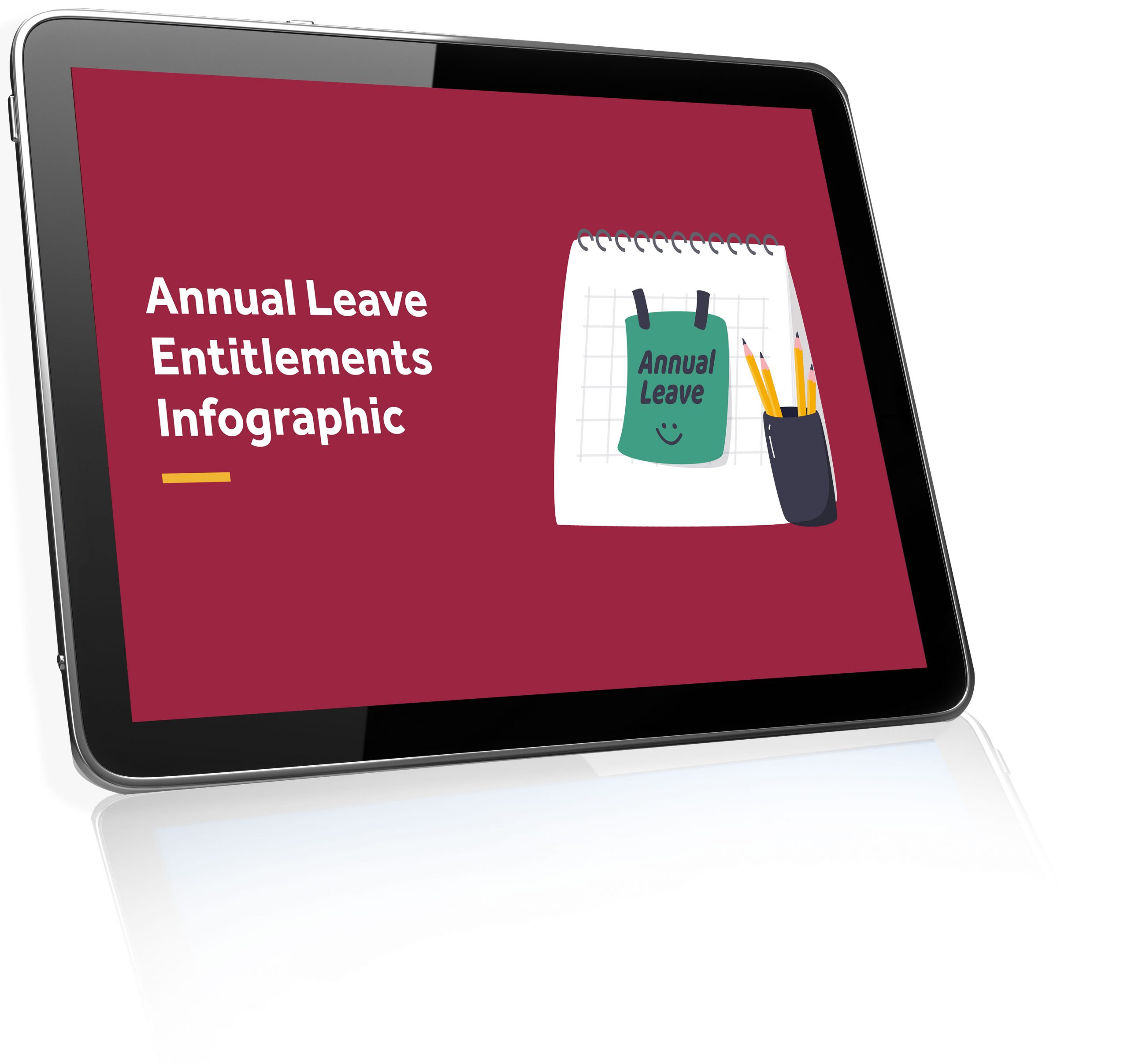
What is annual leave loading?
Leave loading or holiday leave loading means an employee taking annual leave is entitled to an extra payment on top of their base rate of pay either upon the commencement or during a period of annual leave.
While the loading amount (if any) varies depending upon the industrial instrument which covers the employee’s employment, it is often 17.5% of their base rate or their usual rate of pay. However, the loading may be equal to a shift loading or the weekend penalty rate, whichever is higher, depending on when the leave is taken. Not every employee is entitled to leave loading.
Leave loading, holiday loading or annual leave loading, is an extra payment employees may be entitled to on top of their usual pay whilst on annual leave.
The National Employment Standards (NES) – a set of standards that form part of the Fair Work Act 2009 and apply to all employees covered by the national workplace relations system – prescribe a minimum of four weeks paid annual leave per year for full-time and part-time employees regardless of any award, agreement or contract.

Eligibility
Eligibility for annual leave loading and the loading that applies is derived from the award or enterprise agreement that applies to the employee. If they are not covered by an award or registered agreement, then an employment contract with the employer may provide for annual leave loading.
Employees under many Modern Awards or registered agreements are entitled to a loading when the employee takes paid annual leave. If the employee doesn’t fall under a relevant Award or registered agreement, they will be paid at their base pay rate or the rate at which they are usually paid.
A full-time employee is entitled to four weeks annual leave per year based on their ordinary hours of work up to 38 hours a week, and part-time employees are entitled to pro-rata paid leave according to the number of hours they work. Shift workers may be entitled to more. Whether or not an employee is a shiftworker will depend on the definition in the relevant award or registered agreement that applies to that employee.
It is also important to remember that unless it is otherwise provided by an industrial instrument, annual leave loading is payable on all accrued annual leave when it is taken by the employee. Meaning that it is not restricted to just the current year’s accrual, as untaken annual leave carries over from year to year.
Annual Leave Loading on Termination
In the case of an employee’s termination, that employee must be paid out their remaining unused annual leave, and annual leave loading on top if they are entitled to it. If an employee is entitled to annual leave loading during their employment, it also has to be paid out when employment ends.
However, some employees may receive an annual salary or an all-inclusive hourly rate that incorporates annual leave loading, in which case it does not need to be paid separately. Whether it is included in the salary amount or forms part of an hourly rate will usually be stated in the employment contract.
Annual leave loading on termination is paid out even when an award, registered agreement or employment contract says that it’s not as the entitlement is based on a provision of annual leave on termination within the Fair Work Act 2009. The provision states that if an employee is terminated and they have a period of unused annual leave, they must be paid out what they would have been paid had they taken that period of annual leave.
Understand Annual Leave Loading
Call our Advice Line to get all your tricky questions answered.
Payment
An employee must be paid at least their base rate of pay for the hours they ordinarily would have worked during a period of annual leave up to 38 hours a week, unless their award, registered agreement or contract provides a greater entitlement. The base rate of pay generally does not include penalties, allowances, loadings or bonuses.
The applicable award or registered agreement may provide for a different method of payment for annual leave and will determine whether employees may be entitled to be paid annual leave loading on top of their base pay rate when they take annual leave and how it should be applied.
Some awards stipulate that employees get paid the higher of the following, calculated over the whole period of leave that is taken:
a 17.5% loading on the employee’s base rate of pay for the job they do under the award classification for the ordinary hours they would have worked if they weren’t on leave; or
the employee’s normal (over-award) rate of pay for the hours they would have worked if they weren’t on leave plus 17.5% loading; or
the weekend penalty rates the employee normally gets if they would have worked (plus shift loading if the employee is a shiftworker).
Annual leave loading calculator
Andy works 5 hours each day from Tuesday to Saturday, which is a total of 25 hours every week. His minimum hourly rate is $20 per hour. He gets paid a 25% weekend penalty on Saturday. His Saturday pay rate is $25 per hour.
Andy takes one week of annual leave. For this week, he gets paid the higher of:
his minimum weekly rate plus 17.5% leave loading or
his minimum weekly rate plus weekend penalties
Minimum weekly pay without weekend penalties
25 hours x $20= $500
Minimum weekly pay plus leave loading
$500 + 17.5%= $587.50
Minimum weekly pay plus weekend penalties
20 hours x $20=$400
5 hours x $25= $125
=$525
Andy’s minimum weekly pay plus leave loading is higher than her minimum weekly pay plus weekend penalties. Andy gets paid $587.50 for his week of annual leave.
Pro-rata Annual leave
Annual leave is accrued on a pro-rata basis. This means that if you work half a year, you will be entitled to half your annual leave.
Pro-rata Loading
If you receive your leave loading on a pro-rata basis, the leave loading payment will be added to your earnings for this period and will be taxed accordingly.
Frequently Asked Questions
What Is Leave Loading?
Annual leave loading is an extra payment that some employees receive when taking annual leave on top of their base or usual rate of pay.
What is Holiday Leave Loading?
Holiday Leave Loading is the same as annual leave loading.
Is Annual Leave Loading Compulsory?
The source of an entitlement to leave loading is usually the applicable Award or agreement, or the contract of employment. If the employee is entitled to annual leave loading, then yes, it is compulsory for the employer to provide it, though it may already be accounted for if the employee has an annual salary or an all-inclusive hourly rate. Usually the employment contract will indicate what is included in the employee’s normal rate of pay.
Who is entitled to Leave Loading?
Not all employees are entitled to leave loading. Eligibility for annual leave loading is derived from the award or enterprise agreement that applies to the employee.
Do Employers Have To Pay Leave Loading?
This will depend upon the industrial instrument (if any) which covers the relevant employee.
If the employee is entitled to annual leave loading, then yes, it is compulsory for the employer to provide it, though it may already be accounted for if the employee has an annual salary or an all-inclusive hourly rate.
How Much Is Annual Leave Loading?
The amount of annual leave loading is dependent on the industry within which you are working and the specific employee’s arrangements. Most modern awards provide that annual leave loading is the higher of 17.5% compared to the weekend penalty rate the employee would normally get if leave is taken on a weekend, including any shift loading if the employee is a shift worker.
How is leave loading calculated?
To calculate your leave loading, use this formula:
4 x 17.5% x Employee’s Weekly Rate of Pay
What Does Pro Rata Leave Mean?
Annual leave accumulates on the ordinary hours that an employee normally works, up to 38 hours a week. Part-time employees get 4 weeks annual leave on a pro-rata basis. That means that a part-time employee who works 20 hours per week for a year will accumulate 80 hours of annual leave, which equates to 4 weeks work.
Do Part-Time Employees Get Annual Leave Loading?
Yes. If the part-time employee’s applicable award, enterprise agreement or an employment contract allows for annual leave loading, then it should be paid for those days that the employee takes annual leave.
When Does Annual Leave Loading Get Paid?
Annual leave loading is generally paid at the same time the employee is paid for their annual leave. An employer is usually only required to make payments to employees on annual leave in accordance with their normal pay cycle. However, an award or registered agreement may require payment for annual leave and the corresponding annual leave loading to be made prior to the leave being taken.
Is Annual Leave Loading Included In Annual Leave Payouts?
Unused annual leave is included in an employee’s final pay at the end of their employment. If the employee was entitled to payment of annual leave loading as a result of their award or enterprise agreement or contract then they will be entitled to payment of the applicable annual leave loading over the remaining leave.
If the employee is cashing out their annual leave, then the payment for cashed out annual leave has to be the same as what the employee would have been paid if they took the leave, so if leave loading applies it will also need to be paid with the annual leave.
Is Annual Leave Loading Paid On Termination?
Yes, unused annual leave is included in an employee’s final pay at the end of their employment. If the employee was entitled to payment of annual leave loading as a result of their award or enterprise agreement or contract, then they will be entitled to payment of the applicable annual leave loading over the remaining leave.
What is the leave loading in Queensland?
Leave loading is a national award, therefore, it will not differ across states. In Queensland is just as applicable as it is in New South Wales.
What is SGC on Leave Loading?
According to the Australian Taxation Office (ATO), your employer needs to include annual leave loading payments in your earnings and calculate the superannuation guarantee contributions (SGC) using the total. This is applicable only if you qualify for SG contributions. Please consult a professional before making any financial decisions.
What is a Loading Rate?
An agreement can included loaded rates of pay which compensate for benefits provided for in the relevant modern award. In circumstances where an award benefit is incorporated into the agreement hourly rate of pay, that rate will need to be increased to compensate for the removal of award benefits that would no longer apply.
Please note that we cannot guarantee or accept any liability for the accuracy, reliability, currency, or completeness of the information available in this guide. When considering the information available about awards or pay rates, you should contact employment relations experts. Alternatively, you may wish to get independent advice from a legal professional based on your circumstances.



